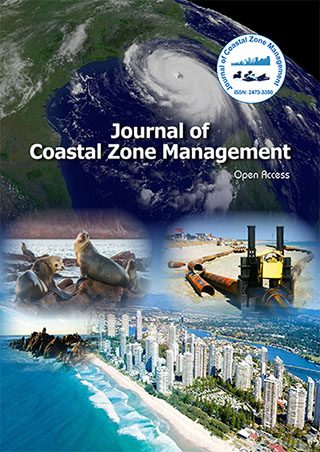Indexed In
- SafetyLit
- RefSeek
- Hamdard University
- EBSCO A-Z
- OCLC- WorldCat
- Publons
Useful Links
Share This Page
Journal Flyer

Open Access Journals
- Agri and Aquaculture
- Biochemistry
- Bioinformatics & Systems Biology
- Business & Management
- Chemistry
- Clinical Sciences
- Engineering
- Food & Nutrition
- General Science
- Genetics & Molecular Biology
- Immunology & Microbiology
- Medical Sciences
- Neuroscience & Psychology
- Nursing & Health Care
- Pharmaceutical Sciences
Commentary - (2025) Volume 28, Issue 1
From Waves to Dunes: Unraveling Coastal Geomorphology
Alexis Hill*Received: 14-Jul-2023, Manuscript No. JCZM-23-22190; Editor assigned: 17-Jul-2023, Pre QC No. JCZM-23-22190 (PQ); Reviewed: 31-Jul-2023, QC No. JCZM-23-22190; Revised: 23-Jan-2025, Manuscript No. JCZM-23-22190 (R); Published: 30-Jan-2025, DOI: 10.35248/2473-3350.25.28.660
Description
Coastal geomorphology is a fascinating field of study that explores the processes and landforms shaped by the dynamic interaction between waves and coastal environments. This article takes you on a journey through the intricate world of coastal geomorphology, unraveling the fascinating processes from waves to dunes that shape our coastal landscapes.
The power of waves: Waves are one of the primary agents of change along coastlines. Geomorphologists analyze wave characteristics, such as height, period, and direction, to understand their erosional and depositional impacts. Waves carry energy from the open ocean to the shore, shaping the coastline through processes like erosion, transport, and sediment deposition.
Erosion and sediment transport: Coastal waves have the power to erode and transport sediment along the coastline. Geomorphologists investigate how wave energy interacts with coastal landforms such as cliffs, headlands, and rocky shores, causing erosion and shaping the coastline over time. They study sediment transport processes, including longshore drift and offshore sediment movement, to comprehend the movement of sediments along the coast.
Beaches: Dynamic landforms in motion: Beaches are iconic features of coastal landscapes, shaped by the interplay of waves, tides, and sediment. Geomorphologists examine beach morphology, sediment sources, and processes such as wave swash and backwash. They investigate the complex interactions between waves, currents, and sediment transport to understand the formation, evolution, and stability of beaches. By studying beach dynamics, geomorphologists contribute to coastal management strategies and the preservation of valuable coastal resources.
Barrier islands: Nature's defense: Barrier islands are elongated landforms that run parallel to the mainland, providing a natural buffer against the open ocean. Geomorphologists delve into the formation, migration, and evolution of barrier islands, uncovering the processes that shape these dynamic landforms. They analyze sediment budgets, wave climate, and sea-level changes to understand the vulnerability of barrier islands to erosion and predict their response to future environmental changes.
Dunes: Guardians of the coast: Dunes are another important feature of coastal landscapes, formed through the accumulation of wind-blown sand. Geomorphologists study dune formation, migration, and stabilization processes. They investigate factors such as wind patterns, sediment availability, and vegetation cover to understand the dynamics of dune systems. By unraveling the mechanisms behind dune formation and the impacts of human activities, geomorphologists contribute to the preservation of dunes as natural defenses against erosion and storm surges.
Estuaries: Where land and sea meet: Estuaries are unique coastal features formed by the interaction of rivers and the sea. Geomorphologists explore the geomorphology of estuaries, studying sedimentation patterns, tidal dynamics, and interactions between freshwater and saltwater. They analyze the formation of landforms such as tidal flats, salt marshes, and mudflats to understand the processes that shape these ecologically rich environments. This knowledge contributes to the sustainable management and conservation of estuarine ecosystems.
Human interactions and coastal geomorphology: Human activities can have a significant impact on coastal geomorphology. Geomorphologists investigate the effects of coastal engineering structures, such as seawalls and groynes, on coastal processes and landform evolution. They also assess the consequences of human-induced changes, such as beach nourishment and sand mining, on coastal dynamics. By understanding the complex interactions between human interventions and natural processes, geomorphologists contribute to sustainable coastal management and the protection of coastal environments.
Coastal geomorphology provides valuable insights into the dynamic processes that shape our coastal landscapes, from the power of waves to the formation of dunes. Geomorphologists study the interaction between waves, sediment, and landforms, uncovering the mechanisms that shape coastlines, beaches, barrier islands, dunes, and estuaries. Their research contributes to our understanding of coastal evolution, the preservation of natural defenses against erosion, and the sustainable management of coastal resources. By unraveling the mysteries of coastal geomorphology, we gain a deeper appreciation for the ever-changing beauty of our coastal environments.
Citation: Hill A (2025) From Waves to Dunes: Unraveling Coastal Geomorphology. J Coast Zone Manag. 28:660.
Copyright: © 2025 Hill A. This is an open access article distributed under the terms of the Creative Commons Attribution License, which permits unrestricted use, distribution, and reproduction in any medium, provided the original author and source are credited.
